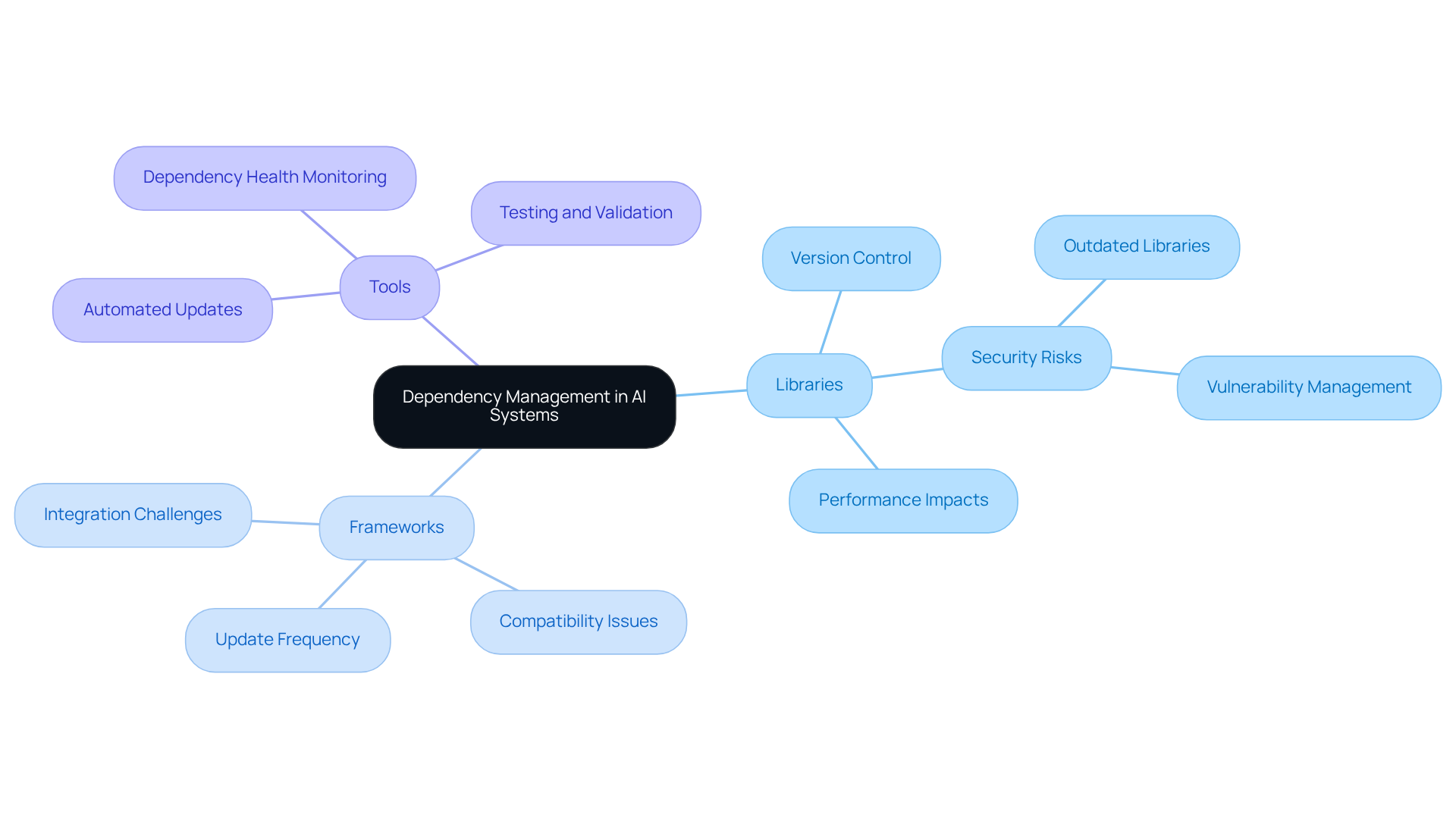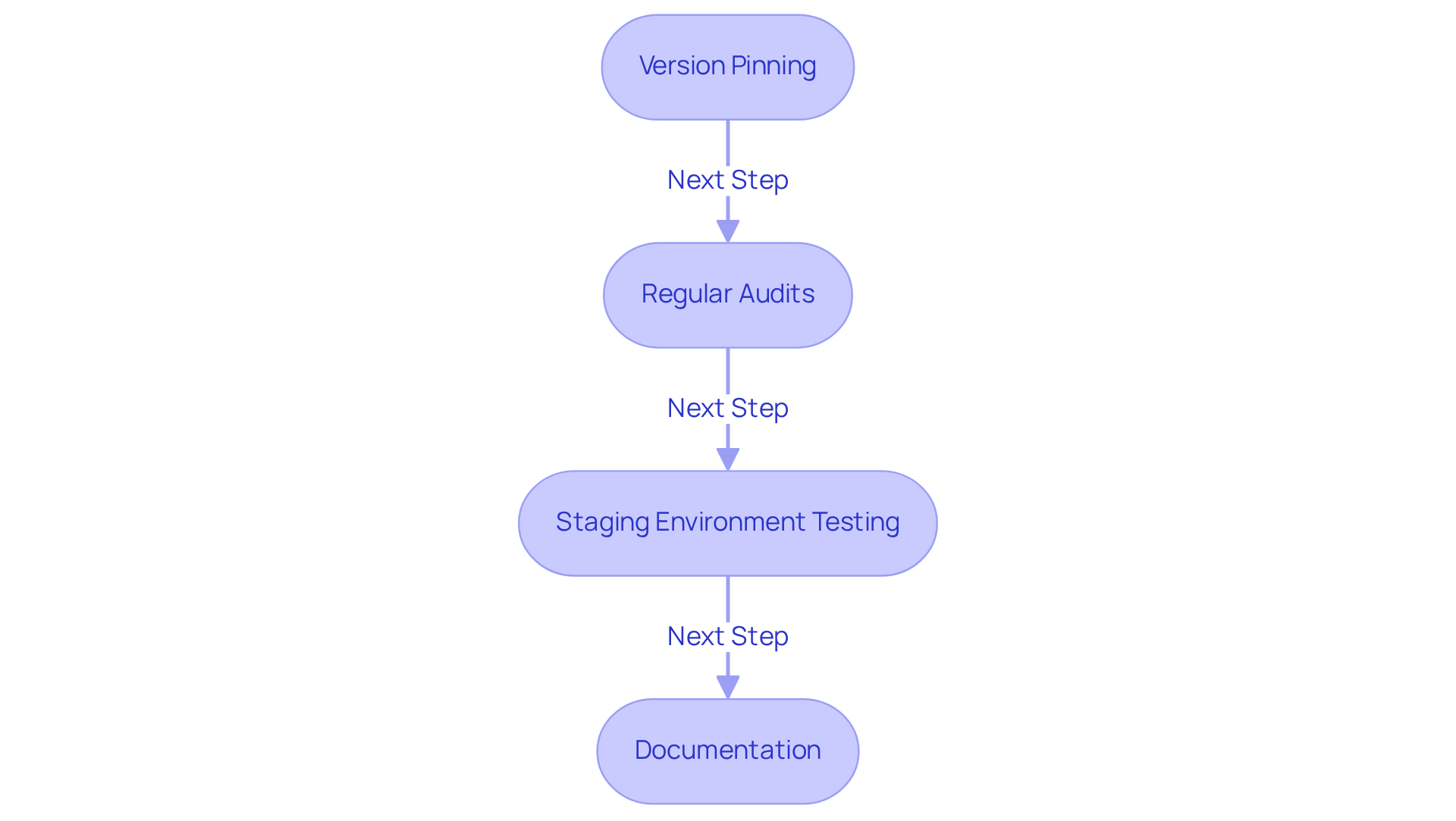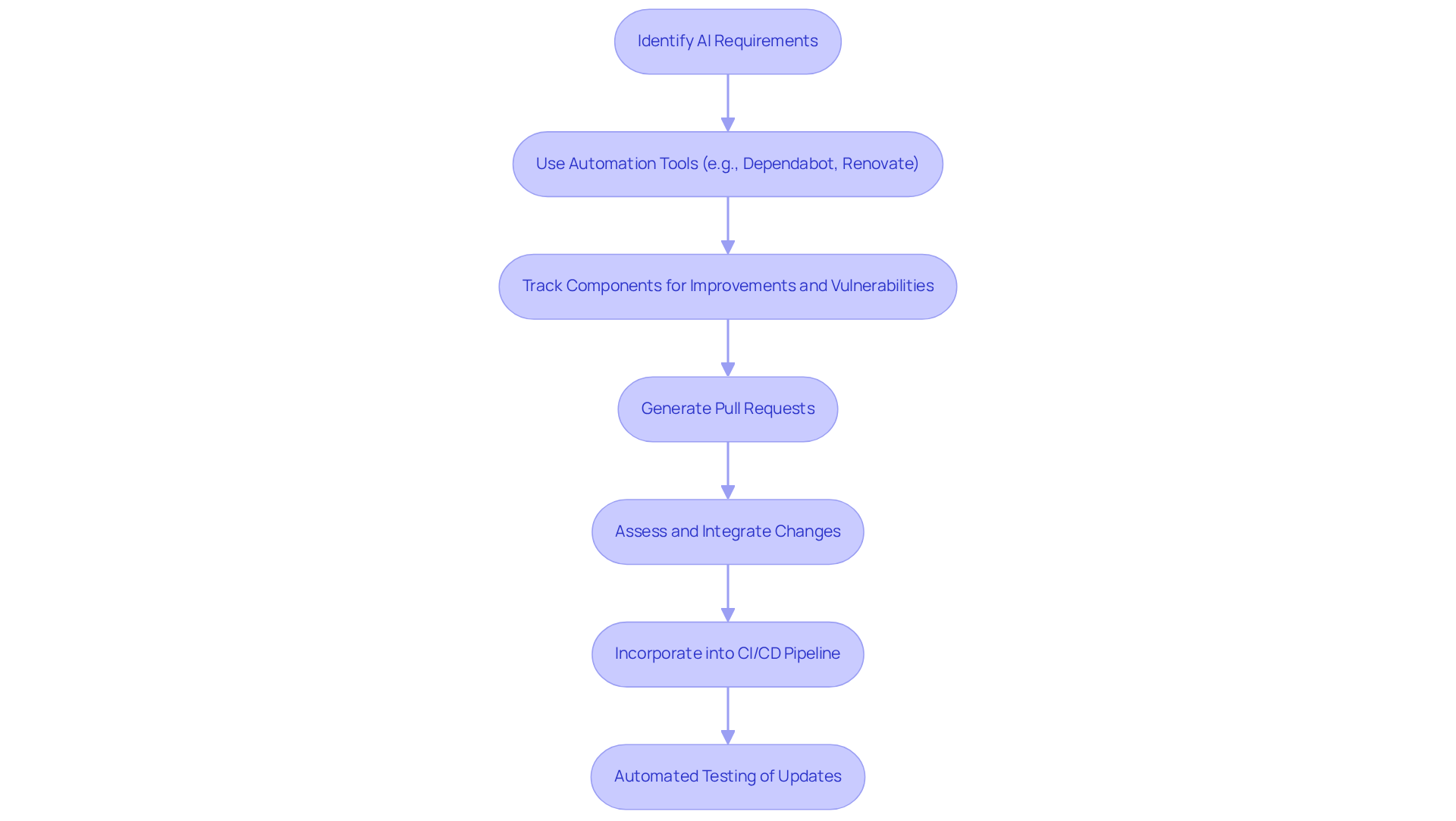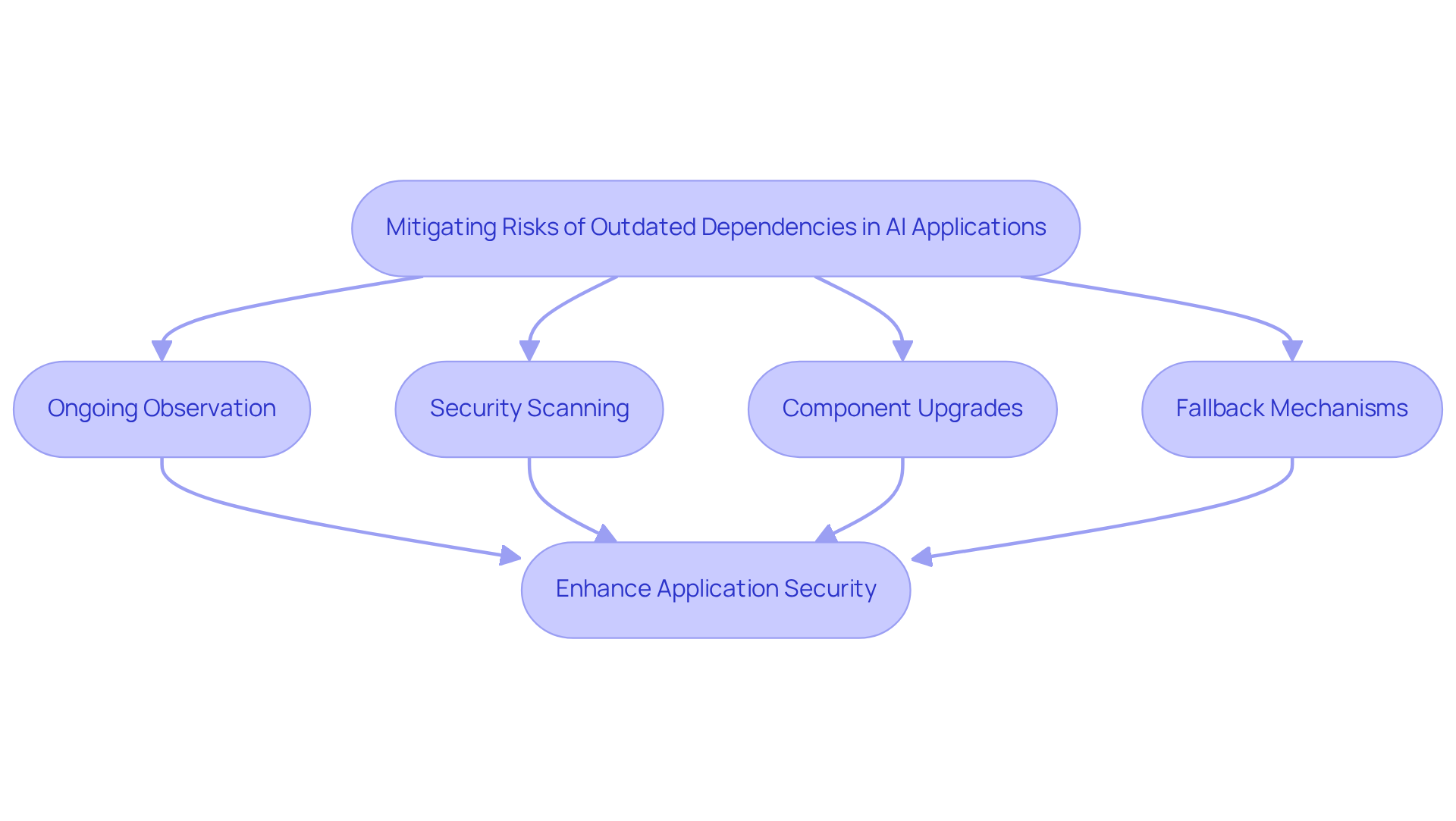Overview
Effective management of AI update dependencies is crucial for maintaining the performance, security, and stability of AI applications. Have you ever faced challenges with outdated components? This article outlines four key strategies to address these challenges:
- Version pinning
- Regular audits
- Staging environment testing
- Thorough documentation
By proactively managing dependencies, teams can mitigate risks associated with outdated components and enhance overall system reliability. Furthermore, these strategies not only safeguard your applications but also improve productivity and code quality. Explore these tools to ensure your AI systems remain robust and efficient.
Introduction
Efficient dependency management serves as the backbone of successful AI systems, where the interplay between libraries, frameworks, and tools can significantly influence application performance. This article explores four strategic approaches designed to enhance the stability and security of AI applications. These strategies empower teams to proactively manage their update dependencies. Furthermore, with the rapid evolution of technology, how can organizations ensure they are not only keeping pace but also safeguarding against the myriad vulnerabilities that arise from outdated components?
Understand Dependency Management in AI Systems
Efficient management of relationships in AI systems is crucial for monitoring and regulating the AI update dependencies related to the libraries, frameworks, and tools that support your AI applications. These requirements encompass machine learning libraries, data processing frameworks, and hardware drivers. A comprehensive understanding of how these elements interact is essential, as failing to update AI dependencies can result in significant performance declines, security vulnerabilities, and even system failures.
To manage connections effectively, teams should maintain a detailed list of all associations, including their versions and relationships. This practice not only facilitates troubleshooting but also simplifies updates and the integration of new features. As Sundar Pichai emphasizes, the future of AI depends on enhancing human capabilities, which includes ensuring that the tools we depend on are current and secure. Regularly using AI to update dependencies can prevent up to 90% of newly discovered vulnerabilities, underscoring the importance of proactive management.
Real-world examples illustrate the impact of outdated components on AI performance and security. For instance, in 2021, over 90% of npm CVEs were found in outdated versions of libraries, which highlights the risks associated with neglecting to update AI dependencies. By prioritizing resource management, organizations can enhance the reliability and security of their AI applications, ultimately leading to improved performance and increased user trust.

Implement Best Practices for Updating AI Dependencies
To efficiently refresh AI update dependencies, teams should adopt several best practices that tackle common coding challenges faced by developers.
- Version Pinning: Always pin requirements to specific versions to avoid unexpected changes when updates occur. This practice ensures that your application remains stable and predictable, especially when you ai update dependencies, allowing for smoother development processes.
- Regular audits of your dependencies should be conducted to identify outdated or vulnerable packages in order to ai update dependencies. Tools like
npm auditorpip-auditcan automate this process, making it easier to maintain security and performance. - Staging Environment Testing: Before implementing changes to production, test them in a staging environment to catch any issues early. This step is essential for guaranteeing that modifications do not interfere with current functionality, ultimately saving time and resources.
- Documentation: Keep comprehensive records of all components and their revision history. This practice assists in monitoring alterations and understanding the effects of modifications on your system, promoting better collaboration among team members.

Leverage Automation Tools for Efficient Dependency Management
Automation tools are essential for effectively managing AI requirements, particularly in the face of common coding challenges developers encounter. Tools like Dependabot and Renovate automatically track components for improvements and vulnerabilities, significantly enhancing the maintenance process. They generate pull requests for modifications, enabling teams to assess and integrate changes effortlessly. This not only fosters a collaborative atmosphere but also streamlines the development cycle. Furthermore, incorporating these tools into your CI/CD pipeline ensures that AI update dependencies undergo automated testing, thereby reducing the risk of introducing errors into the production environment. This automation empowers teams to respond swiftly to emerging vulnerabilities or performance issues, ultimately leading to a more resilient and agile software development process.

Mitigate Risks of Outdated Dependencies in AI Applications
In the fast-evolving landscape of AI applications, developers face significant challenges related to AI update dependencies. To effectively mitigate these risks, teams should adopt several key strategies.
- Ongoing Observation: How often do you evaluate the status of your resources? Utilizing monitoring tools that consistently assess your environment is crucial. This proactive approach allows teams to identify vulnerabilities as they arise, ensuring timely responses to potential threats. As Geoffrey Hinton warns, the rapid advancement of AI systems necessitates vigilant monitoring to prevent vulnerabilities from being exploited. Kodezi CLI can autonomously improve your codebase, helping to identify and rectify issues before they escalate.
- Security Scanning: Are you regularly scanning your codebase for known vulnerabilities? Tools such as OWASP Dependency-Check or GitHub's built-in security features can help maintain a secure environment by flagging outdated or vulnerable components. According to a report by the World Economic Forum, neglecting to refresh components can lead to major security breaches, costing organizations billions. Kodezi's AI-powered capabilities can assist in analyzing bugs and optimizing your code, ensuring that security remains a priority.
- Component Upgrades: When was the last time you reviewed your critical components? Prioritizing enhancements for components recognized as having security vulnerabilities or performance issues is essential. Establishing a routine for reviewing and updating these components can significantly enhance overall application stability and security. The Magecart attacks serve as a stark reminder of the repercussions of using obsolete components, emphasizing the need for frequent updates. Kodezi's autonomous solutions simplify this process, making it easier for teams to keep their requirements current.
- Fallback Mechanisms: Do you have strategies in place for when dependencies fail? Incorporating fallback strategies within your software is vital for handling situations where a reliance acts unpredictably. This approach helps preserve system stability, ensuring that connection issues do not disrupt overall functionality. By utilizing Kodezi's self-sufficient monitoring and repair features, teams can ensure their software remains robust against new threats.
By integrating these strategies, teams can enhance their approach to AI update dependencies, ensuring that their AI applications remain secure, stable, and resilient against emerging threats. Explore the tools available on the Kodezi platform to elevate your coding practices and safeguard your projects.

Conclusion
Effective management of AI update dependencies is crucial for ensuring the reliability, security, and performance of AI applications. By understanding the intricate relationships between various components, organizations can proactively address potential vulnerabilities and performance issues that may arise from outdated dependencies. This focus on dependency management not only enhances the overall functionality of AI systems but also builds user trust and confidence.
The article outlines several key strategies for managing AI update dependencies effectively. These include:
- Maintaining a detailed list of dependencies
- Implementing version pinning
- Conducting regular audits
- Utilizing staging environments for testing
- Leveraging automation tools to streamline the updating process
Furthermore, ongoing observation, security scanning, component upgrades, and fallback mechanisms are critical for mitigating the risks associated with outdated dependencies. Each of these practices plays a vital role in fostering a secure and stable AI environment.
In a rapidly evolving technological landscape, the importance of staying current with AI dependencies cannot be overstated. Embracing these best practices not only protects organizations from security breaches and performance declines but also positions them to respond swiftly to emerging threats. By prioritizing dependency management and leveraging available tools, teams can ensure their AI applications remain resilient and capable of meeting the demands of the future.
Frequently Asked Questions
Why is dependency management important in AI systems?
Dependency management is crucial in AI systems to monitor and regulate the update dependencies related to libraries, frameworks, and tools that support AI applications. Failing to update these dependencies can lead to performance declines, security vulnerabilities, and system failures.
What should teams do to manage dependencies effectively?
Teams should maintain a detailed list of all associations, including their versions and relationships. This practice aids in troubleshooting, simplifies updates, and facilitates the integration of new features.
How can using AI help with dependency updates?
Regularly using AI to update dependencies can prevent up to 90% of newly discovered vulnerabilities, highlighting the importance of proactive management in maintaining security and performance.
What are some real-world consequences of outdated dependencies in AI applications?
Outdated components can significantly impact AI performance and security. For example, in 2021, over 90% of npm Common Vulnerabilities and Exposures (CVEs) were found in outdated versions of libraries, illustrating the risks of neglecting dependency updates.
What is the overall impact of prioritizing resource management in AI?
By prioritizing resource management, organizations can enhance the reliability and security of their AI applications, leading to improved performance and increased user trust.




